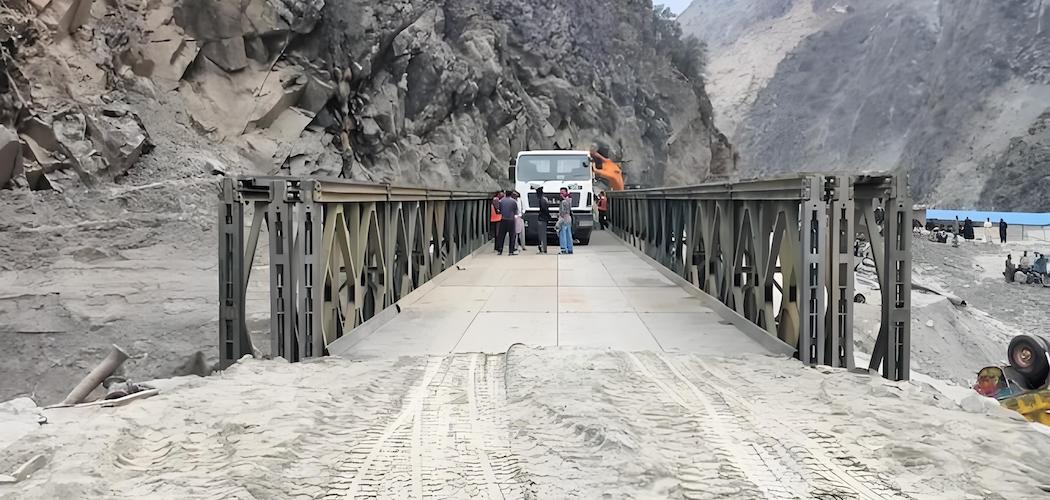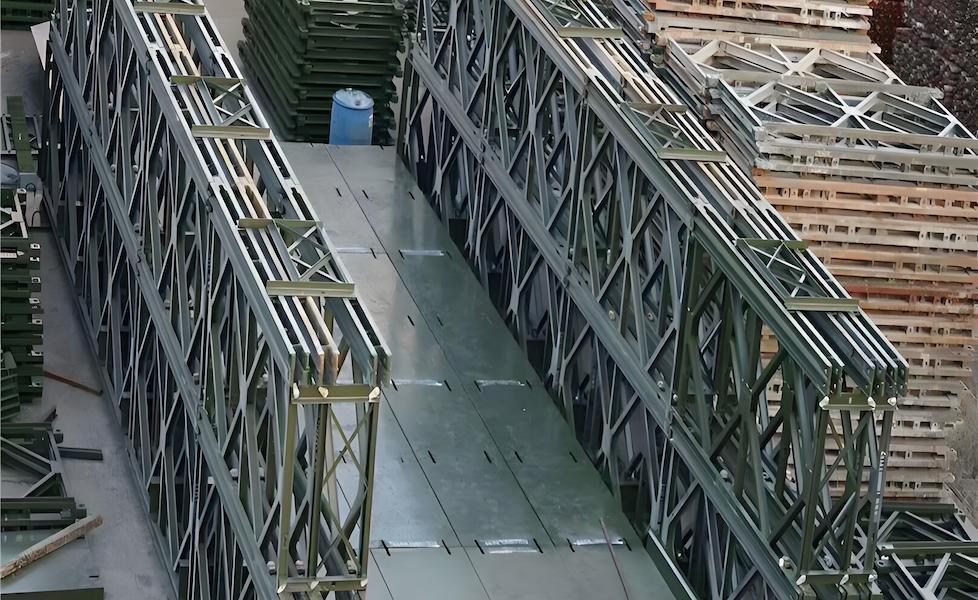Views: 211 Author: Site Editor Publish Time: 2025-10-29 Origin: Site









Content Menu
● Understanding Modular Steel Bridges
>> Definition and Characteristics
● Advantages of Modular Steel Bridges
● The Role of Modular Steel Bridges in Disaster Recovery
>> Supporting Emergency Response
● Case Studies of Modular Steel Bridges in Action
>> Recent Disaster Recovery Efforts
>> Long-Term Resilience Planning
● Challenges and Considerations
>> Regulatory and Permitting Issues
● Future Trends in Modular Steel Bridge Technology
>> Innovations in Design and Materials
>> Integration with Smart Technology
● Frequently Asked and Questions regarding Modular Steel Bridges
>> 1. What are the typical load capacities of modular steel bridges used in disaster recovery?
>> 2. How do modular steel bridges compare to concrete bridges in terms of environmental impact?
>> 3. What are the best practices for maintaining modular steel bridges in disaster-prone areas?
>> 4. How quickly can modular steel bridges be deployed after a disaster?
>> 5. What role do modular steel bridges play in long-term infrastructure planning?
In the wake of natural disasters, infrastructure resilience becomes a critical focus for communities striving to recover and rebuild. Among the various solutions available, modular steel bridges have emerged as a vital component in disaster recovery efforts. This article explores the significance of modular steel bridges, their advantages, and their role in enhancing the resilience of communities affected by disasters.
Modular steel bridges are prefabricated structures designed for quick assembly and disassembly. They are constructed using steel components that are manufactured off-site and transported to the installation location. This modular approach allows for rapid deployment, making them ideal for emergency situations where time is of the essence. The components are engineered to fit together seamlessly, ensuring structural integrity and safety. This prefabrication process not only speeds up construction but also minimizes the disruption to the surrounding environment, which is particularly important in disaster recovery scenarios where communities are already facing significant challenges.
One of the key characteristics of modular steel bridges is their design flexibility. These bridges can be customized to meet specific site requirements, including span length, load capacity, and aesthetic considerations. This adaptability ensures that modular bridges can be effectively integrated into various environments, from urban settings to remote areas. Engineers can tailor the design to accommodate local conditions, such as river widths or terrain variations, ensuring that the bridge serves its purpose effectively. Furthermore, the ability to modify designs allows for the incorporation of local cultural elements, making the bridges not only functional but also a part of the community's identity.
In disaster recovery scenarios, the speed of installation is paramount. Modular steel bridges can be assembled quickly, often within a matter of days. This rapid deployment is crucial for restoring transportation routes and facilitating the movement of emergency services, supplies, and personnel. The quick installation process is particularly beneficial in situations where traditional construction methods would take weeks or even months, delaying critical aid. Additionally, the ability to deploy these bridges swiftly can significantly reduce the economic impact of a disaster by allowing businesses and services to resume operations sooner.
The use of modular steel bridges can also lead to significant cost savings. The prefabrication process reduces on-site labor costs and minimizes construction time, which can be particularly beneficial in disaster-stricken areas where resources are limited. Additionally, the durability of steel reduces long-term maintenance costs, making these bridges a financially sound investment. The initial savings in construction can be further enhanced by the reduced need for ongoing repairs and maintenance, as steel bridges are less susceptible to damage from environmental factors compared to other materials. This cost-effectiveness makes modular steel bridges an attractive option for municipalities and organizations looking to maximize their disaster recovery budgets.
Steel is known for its strength and resilience, making modular steel bridges highly durable. They can withstand harsh weather conditions, heavy loads, and seismic activity, which is essential in regions prone to natural disasters. The longevity of these structures ensures that they remain functional and safe for years, providing a reliable transportation solution for communities. Moreover, the corrosion-resistant coatings applied to steel components enhance their lifespan, reducing the frequency of repairs and replacements. This durability not only benefits immediate recovery efforts but also contributes to long-term infrastructure stability, allowing communities to focus on rebuilding rather than constant maintenance.
One of the primary roles of modular steel bridges in disaster recovery is restoring connectivity. After a disaster, many roads and bridges may be damaged or destroyed, isolating communities and hindering relief efforts. Modular steel bridges can be deployed quickly to reconnect these areas, allowing for the efficient transport of aid and resources. This restoration of connectivity is vital for ensuring that emergency services can reach affected populations, and it also facilitates the movement of goods and services necessary for recovery. By re-establishing transportation links, modular bridges help to restore normalcy and support the psychological well-being of communities as they begin to heal.
In the immediate aftermath of a disaster, emergency response teams require access to affected areas to provide assistance. Modular steel bridges facilitate this access by providing safe and reliable routes for emergency vehicles. Their rapid installation ensures that first responders can reach those in need without delay. This capability is crucial in saving lives, as timely access to medical care, food, and shelter can make a significant difference in the aftermath of a disaster. Furthermore, the presence of reliable transportation routes allows for better coordination among various response agencies, enhancing the overall effectiveness of disaster management efforts.
The economic impact of disasters can be devastating, with damaged infrastructure leading to business closures and job losses. By restoring transportation routes, modular steel bridges play a crucial role in enabling economic recovery. They allow for the movement of goods and services, helping businesses to resume operations and communities to rebuild. The quicker businesses can reopen, the faster local economies can recover, reducing the long-term financial strain on residents and municipalities. Additionally, the construction of modular bridges can create temporary jobs, further stimulating the local economy during the recovery phase.
Several recent disaster recovery efforts have highlighted the effectiveness of modular steel bridges. For instance, in the aftermath of hurricanes and floods, communities have successfully utilized these structures to restore vital transportation links. The ability to quickly deploy modular bridges has proven invaluable in ensuring that relief efforts can proceed without interruption. In some cases, these bridges have been used to replace traditional structures that were completely destroyed, demonstrating their potential as a long-term solution in disaster-prone areas. The success stories from these recovery efforts serve as powerful examples of how modular steel bridges can transform disaster response strategies.
In addition to immediate recovery efforts, modular steel bridges are increasingly being integrated into long-term resilience planning. Communities are recognizing the importance of investing in durable infrastructure that can withstand future disasters. By incorporating modular steel bridges into their infrastructure strategies, local governments are enhancing their ability to respond to and recover from disasters. This proactive approach not only improves immediate recovery capabilities but also fosters a culture of resilience within communities. As more municipalities adopt this forward-thinking mindset, the overall infrastructure landscape is likely to evolve, prioritizing sustainability and adaptability.
While modular steel bridges offer numerous advantages, there are challenges to consider. Site-specific conditions, such as terrain and environmental factors, can impact the feasibility of installation. Engineers must carefully assess these conditions to ensure that the chosen bridge design is suitable for the location. Factors such as soil stability, flood risk, and local wildlife must be taken into account to ensure that the bridge not only serves its purpose but also minimizes environmental impact. Addressing these challenges requires collaboration between engineers, environmental scientists, and local stakeholders to develop solutions that are both effective and sustainable.
Navigating regulatory and permitting processes can also pose challenges for the deployment of modular steel bridges. Local governments may have specific requirements that must be met before installation can occur. Engaging with regulatory bodies early in the planning process can help streamline approvals and facilitate timely deployment. Additionally, public engagement is crucial in addressing community concerns and ensuring that the project aligns with local needs and values. By fostering open communication and collaboration, stakeholders can work together to overcome regulatory hurdles and expedite the recovery process.
The future of modular steel bridges is likely to be shaped by innovations in design and materials. Advances in technology are enabling the development of lighter, stronger materials that can enhance the performance of modular bridges. Additionally, design innovations may lead to more aesthetically pleasing structures that blend seamlessly into their surroundings. These advancements not only improve the functionality of bridges but also enhance their visual appeal, making them more acceptable to communities. As technology continues to evolve, the potential for modular steel bridges to incorporate smart features, such as sensors for monitoring structural health, will further enhance their utility and safety.
As communities increasingly embrace smart technology, modular steel bridges may also incorporate advanced monitoring systems. These systems can provide real-time data on structural integrity, traffic patterns, and environmental conditions, allowing for proactive maintenance and ensuring the safety of users. The integration of smart technology can also facilitate better traffic management, reducing congestion and improving overall transportation efficiency. By leveraging data analytics and IoT (Internet of Things) technologies, modular steel bridges can become integral components of smart city infrastructure, contributing to more sustainable and resilient urban environments.
Modular steel bridges play a crucial role in disaster recovery by providing rapid, cost-effective, and durable solutions for restoring connectivity and supporting emergency response efforts. Their adaptability and resilience make them an essential component of infrastructure planning in disaster-prone areas. As communities continue to face the challenges posed by natural disasters, the importance of modular steel bridges in enhancing resilience and facilitating recovery will only grow. Investing in these structures not only aids in immediate recovery but also contributes to long-term community resilience, ensuring that societies are better prepared for future challenges. By embracing the potential of modular steel bridges, communities can build a more robust infrastructure that supports both recovery and growth in the face of adversity.

Modular steel bridges can typically support load capacities ranging from 10 to 100 tons, depending on their design and intended use. This flexibility allows them to accommodate various vehicles, including emergency response trucks and heavy equipment.
Modular steel bridges generally have a lower environmental impact than concrete bridges. Steel is recyclable, and the prefabrication process reduces on-site waste. Additionally, the shorter construction time minimizes disruption to local ecosystems compared to traditional concrete bridge construction.
Regular inspections and maintenance are crucial for ensuring the longevity of modular steel bridges. Best practices include routine checks for corrosion, structural integrity assessments, and prompt repairs of any damage. Additionally, applying protective coatings can enhance durability against environmental factors.
Modular steel bridges can often be deployed within days of a disaster, depending on the site conditions and logistical considerations. Their prefabricated nature allows for rapid assembly, which is essential for restoring transportation routes quickly.
In long-term infrastructure planning, modular steel bridges are valued for their adaptability and resilience. They can be designed to meet future needs and withstand potential disasters, making them a strategic investment for communities looking to enhance their infrastructure resilience and recovery capabilities.
